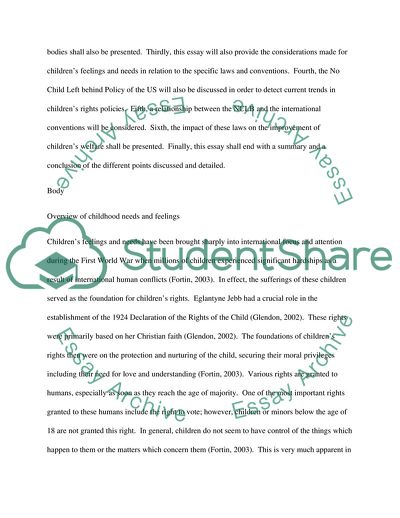Cite this document
(Childhood Needs, Views, Feelings in Relation to National Laws Coursework Example | Topics and Well Written Essays - 4000 words, n.d.)
Childhood Needs, Views, Feelings in Relation to National Laws Coursework Example | Topics and Well Written Essays - 4000 words. https://studentshare.org/law/1788384-childrens-views-needs-wishes-and-feelings-are-at-the-heart-of-national-legislation-and-international-agreements-and-conventions-critically-discuss-the-implications-of-this-for-early-years-practice-in-the-usa
Childhood Needs, Views, Feelings in Relation to National Laws Coursework Example | Topics and Well Written Essays - 4000 words. https://studentshare.org/law/1788384-childrens-views-needs-wishes-and-feelings-are-at-the-heart-of-national-legislation-and-international-agreements-and-conventions-critically-discuss-the-implications-of-this-for-early-years-practice-in-the-usa
(Childhood Needs, Views, Feelings in Relation to National Laws Coursework Example | Topics and Well Written Essays - 4000 Words)
Childhood Needs, Views, Feelings in Relation to National Laws Coursework Example | Topics and Well Written Essays - 4000 Words. https://studentshare.org/law/1788384-childrens-views-needs-wishes-and-feelings-are-at-the-heart-of-national-legislation-and-international-agreements-and-conventions-critically-discuss-the-implications-of-this-for-early-years-practice-in-the-usa.
Childhood Needs, Views, Feelings in Relation to National Laws Coursework Example | Topics and Well Written Essays - 4000 Words. https://studentshare.org/law/1788384-childrens-views-needs-wishes-and-feelings-are-at-the-heart-of-national-legislation-and-international-agreements-and-conventions-critically-discuss-the-implications-of-this-for-early-years-practice-in-the-usa.
“Childhood Needs, Views, Feelings in Relation to National Laws Coursework Example | Topics and Well Written Essays - 4000 Words”. https://studentshare.org/law/1788384-childrens-views-needs-wishes-and-feelings-are-at-the-heart-of-national-legislation-and-international-agreements-and-conventions-critically-discuss-the-implications-of-this-for-early-years-practice-in-the-usa.


